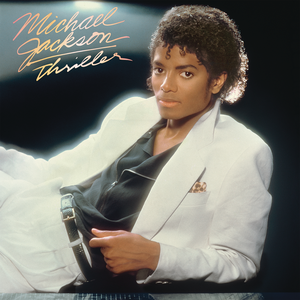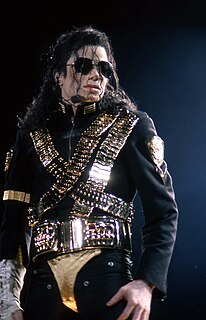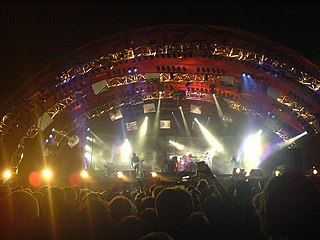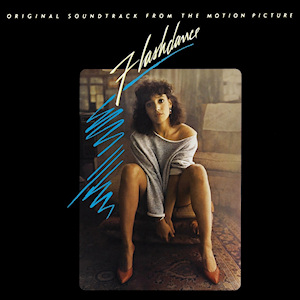
Eurythmics were a British pop duo consisting of Annie Lennox and Dave Stewart. They were both previously in The Tourists, a band which broke up in 1980. The duo released their first studio album, In the Garden, in 1981 to little success, but went on to achieve global acclaim when their second album Sweet Dreams , was released in 1983. The title track became a worldwide hit, reaching #2 in the UK Singles Chart and #6 in Australia, before hitting #1 in Canada and the US Billboard Hot 100. The duo went on to release a string of hit singles and albums, including "Love Is a Stranger", "There Must Be an Angel " and "Here Comes the Rain Again", before they split up in 1990.
Irene Cara Escalera is an American singer and actress. Cara sang and co-wrote the song "Flashdance... What a Feeling", for which she won an Academy Award for Best Original Song and a Grammy Award for Best Female Pop Vocal Performance in 1984. Cara is also known for playing the role of Coco Hernandez in the 1980 film Fame, and for recording the film's title song "Fame". Prior to her success with Fame, Cara portrayed the title character Sparkle Williams in the original 1976 musical drama film Sparkle.

Thriller is the sixth studio album by American singer and songwriter Michael Jackson, released on November 30, 1982, by Epic Records. It was produced by Quincy Jones, who had previously worked with Jackson on his 1979 album Off the Wall. Jackson wanted to create an album where "every song was a killer". With the ongoing backlash against disco music at the time, he moved in a new musical direction, resulting in a mix of pop, post-disco, rock, funk, and R&B sounds. Thriller foreshadows the contradictory themes of Jackson's personal life, as he began using a motif of paranoia and darker themes. The album features a single guest appearance, with Paul McCartney becoming the first artist to be credited as a featured artist on one of Jackson's albums. Recording took place from April to November 1982 at Westlake Recording Studios in Los Angeles, California, with a production budget of $750,000.

Supernatural is the eighteenth studio album by Latin rock band Santana, released on June 15, 1999, on Arista Records. After Santana found themselves without a label in the mid-1990s, founding member and guitarist Carlos Santana began talks with Arista president Clive Davis. Davis had originally signed the group to Columbia Records in 1969 when he was president of that label. Santana and Davis collaborated with A&R man Pete Ganbarg, as Santana wanted to focus on pop and radio-friendly material; Santana collaborated with contemporary guest artists including Eric Clapton, Rob Thomas, Eagle-Eye Cherry, Lauryn Hill, Dave Matthews, Maná, KC Porter and CeeLo Green.

Whitney is the second studio album by American singer Whitney Houston, released on June 2, 1987, by Arista Records as the follow-up to her best-selling debut album, Whitney Houston.

"Thriller" is a song written by Rod Temperton for the American singer Michael Jackson. It was released as a single by Epic Records in November 5, 1983 in the UK, and on January 23, 1984, in the US, as the seventh and final single from Jackson's sixth studio album of the same name. "Thriller" is a mix of post-disco and funk. The song was produced by Quincy Jones and written by Rod Temperton, who wanted to write a theatrical song to suit Jackson's love of film. The music and lyrics evoke horror films, with sound effects such as thunder, footsteps, and wind. It ends with a spoken-word sequence performed by horror actor Vincent Price.

American singer Michael Jackson released 10 studio albums, 3 soundtrack albums, 1 live album, 39 compilation albums, 10 video albums and 8 remix albums. Since his death, 2 albums of unreleased tracks have been posthumously released. Jackson made his debut in 1964 at the age of five with The Jackson 5, who were prominent performers during the 1970s. Jackson is globally recognized as one of the biggest selling music artists in history with over 400 million records sold. According to the Recording Industry Association of America (RIAA), Jackson has sold 89 million certified albums in the United States, making him the sixth top-selling album artist in the country.

"Flashdance... What a Feeling" is a song from the 1983 film Flashdance with music by Giorgio Moroder and lyrics by Keith Forsey and the song's performer, Irene Cara. Moroder had been asked to score the film, and Cara and Forsey wrote most of the lyrics after they were shown the last scene from it in which the main character dances at an audition for a group of judges. They felt that the dancer's ambition to succeed could act as a metaphor for achieving any dream a person has and wrote lyrics that described what it feels like when music inspires someone to dance. The song wound up being used for the scene they watched as well as during the opening credits as the main character is shown working as a welder.

The discography of American pop vocal group Backstreet Boys consists of nine studio albums, 31 singles, one live album, three compilation albums and 33 music videos. Formed in Orlando, Florida in 1993, the group consists of Nick Carter, Brian Littrell, Kevin Richardson, A.J. McLean and Howie Dorough. Richardson left the group in 2006 to pursue other interests, but rejoined in 2012. The Backstreet Boys released their debut single "We've Got It Goin' On" in 1995, which peaked at number sixty-nine on the Billboard Hot 100. The single, however, entered the top ten in many European countries. Their debut album, Backstreet Boys, was released internationally in 1996, and was certified three times platinum in Europe, and diamond in Canada. In 1997, they released their second international album, Backstreet's Back, which continued their international success. At the same time, they released their second self-titled album in the United States. It peaked at number four and eventually became the tenth best-selling album of the 1990s.

American rock band Bon Jovi has released 15 studio albums, three live albums, five compilation albums, five EPs, 66 singles, 14 video albums, and 71 music videos. Bon Jovi has sold over 130 million records worldwide, making them one of the best-selling bands of all time. As of 2018, the band has sold 21.8 million albums in the US Nielsen SoundScan era. Billboard ranked Bon Jovi as the 45th Greatest Artist of all time, achieving 6 No. 1 albums on the Billboard 200 & 4 No. 1 hits on the Billboard Hot 100. According to Recording Industry Association of America, Bon Jovi has sold 34.5 million albums in the United States.

The discography of Metallica includes ten studio albums, eight live albums, three extended plays, 43 singles, ten video albums, 42 music videos, one soundtrack album, one collaboration album and three box sets. They are a San Francisco-based metal band formed in 1981 by James Hetfield and Lars Ulrich (drums). After several bassist and lead guitarist changes, the band settled on Cliff Burton and Kirk Hammett, respectively. Metallica started playing locally, releasing their first widely circulated demo, No Life 'til Leather, in 1982. The demo caught the attention of Johny Zazula, who signed Metallica to Megaforce Records. The band released Kill 'Em All in 1983, and the following year they released Ride the Lightning. After Ride the Lightning was released, Metallica left Megaforce and signed to Elektra Records. In March 1986, the band released its third studio album, Master of Puppets, which was Metallica's first album to be certified gold by the Recording Industry Association of America (RIAA). While promoting the album, Burton was killed in a bus accident. Jason Newsted was hired as a replacement. The band's first release to feature Newsted was The $5.98 E.P. – Garage Days Re-Revisited, and then followed by ...And Justice for All in August 1988, which peaked at number six on the Billboard 200.

The discography of American rock band Tool consists of five studio albums, one box set, two extended plays, four video albums, fifteen singles and eight music videos.

What a Feelin' is the second studio album by American singer-songwriter Irene Cara. Released on November 2, 1983, this album is a continuation of the work that Cara began with producer Giorgio Moroder on the soundtrack to the 1983 film Flashdance. The dance-pop song she co-wrote with Moroder and Keith Forsey for the film, "Flashdance... What a Feeling", went to number one on Billboard magazine's Hot 100 and foreshadowed the style of this album, which was unlike her R&B-heavy debut. Although Cara was more accustomed to composing music, she relinquished most of those duties to Moroder here and shifted much of her songwriting focus to lyrics.

Flashdance: Original Soundtrack from the Motion Picture is the soundtrack to the 1983 film Flashdance, which tells the story of Alex Owens, a welder and exotic dancer who dreams of becoming a professional ballerina. The nightclub performances by Alex and her co-workers and other set pieces involving training and auditioning provided opportunities to present the songs that would make up the soundtrack album. The film's music supervisor, Phil Ramone, made selections that he felt were the best fit for their respective scenes, and composer Giorgio Moroder contributed additional tracks in the process of scoring the film. One of his contributions, "Flashdance...What a Feeling" by Irene Cara, was released as a single in March 1983, weeks before the film's April 15 release, and eventually spent six weeks at number one on the Billboard Hot 100.

"No Air" is a song by American singers Jordin Sparks and Chris Brown. The song was written by James Fauntleroy II, Harvey Mason Jr., Steve Russell, Erik Griggs and Damon Thomas. It was released in the United States on February 11, 2008, and serves as the second single from Sparks' self-titled debut album.

Thaddis Laphonia "Kuk" Harrell is an American songwriter, vocal producer, arranger and engineer. He was a member of a songwriting–production team composed of himself, Christopher "Tricky" Stewart and Terius "The-Dream" Nash. In 2011, Kuk Harrell and partner Tricky Stewart joined the ranks of Fox's American Idol along with music mogul Jimmy Iovine, producing many of the songs performed on television by the contestants and released via iTunes. 2011 marked the highly anticipated return of Jennifer Lopez and her album LOVE? in which Kuk served as Album Vocal Producer. Earning his fourth Grammy for the vocal production of Rihanna's No. 1 Billboard Single "Only Girl ", Harrell is also the vocal producer and co-writer of Rihanna's Grammy-winning single "Umbrella". A composer and engineer on Beyoncé's chart topping "Single Ladies " from the album I Am... Sasha Fierce, he is also vocal producer and engineer of the Diane Warren-penned "I Was Here" from Beyoncé's 2011 album 4. He also produced the majority of the vocals on Mary J. Blige's Platinum album Growing Pains, which won the 2008 Grammy for Best Contemporary R&B Album. The first single from Growing Pains, "Just Fine", earned a Grammy nomination for best R&B vocal performance in 2007.















